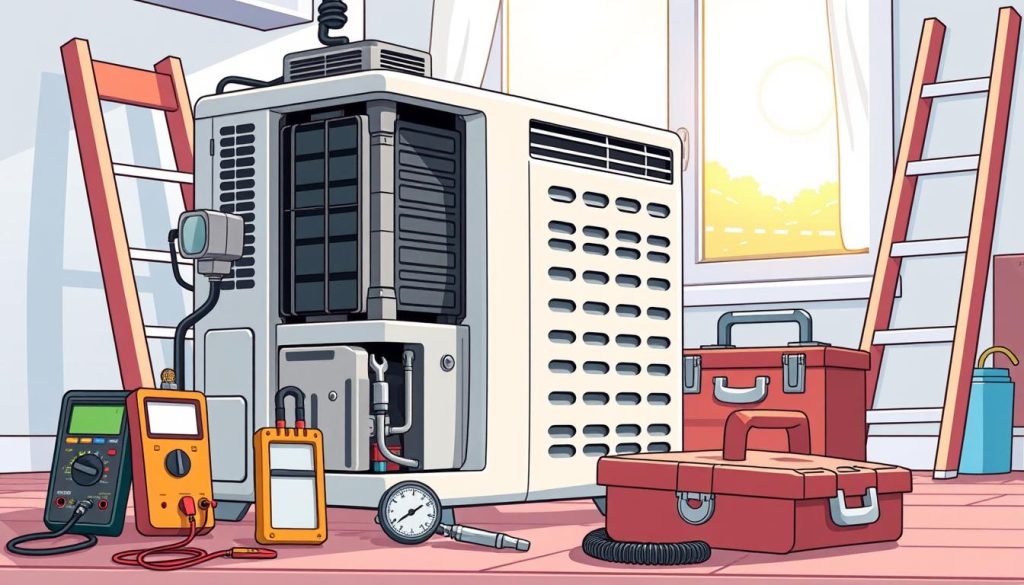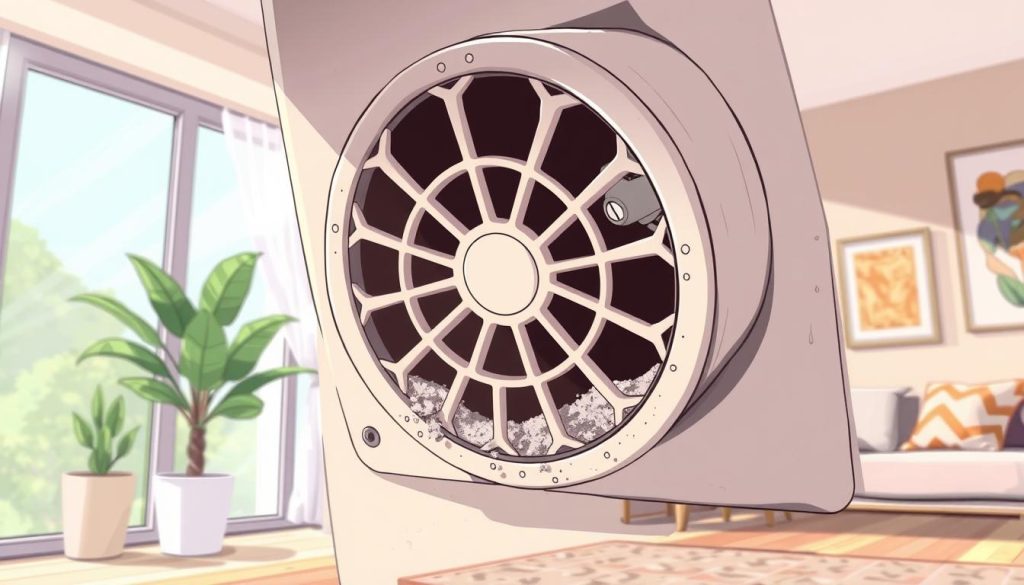When your air conditioning system isn’t working right, it’s key to find the problem first. Knowing common AC issues helps you fix the main problem. This can save you time and money on repairs. We’ll show you how to diagnose your AC issues step by step. This way, you can get your cooling system working again efficiently.
Key Takeaways
- Systematically troubleshoot common AC problems to identify the issue
- Check thermostat settings, replace dirty air filters, and detect refrigerant leaks
- Inspect for a frozen evaporator coil or issues with the condensing unit
- Ensure circuit breakers are functioning properly and air vents are unobstructed
- Addressing AC problems early can save you from costly repairs down the line
Checking Your Thermostat Settings
When your air conditioning system isn’t working right, check your thermostat first. Making sure your thermostat is set correctly can fix problems like inconsistent airflow, temperature reading issues, and no airflow from the registers.
Verify Thermostat Mode and Temperature
First, make sure your thermostat is in “Cool” mode and the temperature is right for you. If it’s not in “Cool” mode or the temperature is too high, your AC won’t cool your home properly.
Check Fan Setting
Look at the fan setting on your thermostat too. It should be set to “Auto” not “On.” Running the fan all the time can cause inconsistent airflow and uneven temperatures in your home.
Review Programmed Schedule
If you have a programmable thermostat, check the schedule. Make sure it matches your daily routine and cooling needs. A wrong schedule can lead to temperature reading issues and no airflow from the registers.
| Thermostat Setting | Potential Issue | Recommended Action |
|---|---|---|
| Not in “Cool” mode | No airflow from registers | Set thermostat to “Cool” mode |
| Temperature set too high | Inconsistent airflow | Adjust temperature setting to desired comfort level |
| Fan set to “On” | Temperature reading issues | Set fan to “Auto” mode |
| Improper programmed schedule | No airflow from registers | Review and adjust programmed temperature settings |
By checking your thermostat settings carefully, you can often fix common air conditioning problems. These include thermostat settings, inconsistent airflow, temperature reading issues, and no airflow from the registers.
Replacing Dirty Air Filters
A dirty air filter is a common cause of air conditioning problems. It can block airflow, leading to issues like warmer air and weak airflow. It can even cause the AC to turn on and off too quickly.
It’s important to replace your air filter regularly to keep your home comfortable and energy-efficient. Check your owner’s manual for the right time to change it, usually every 1-3 months. A clean filter helps your AC work better, saving energy and keeping you cool.
Warmer Air Temperature
A clogged air filter limits air flow to your AC. This can make the air warmer, as your AC struggles to cool it. A dirty filter makes your AC work harder, raising your energy bills and lowering comfort.
Weak Airflow
A blocked air filter also weakens airflow through your system’s registers. This can cause some rooms to be cooler than others. It can also lead to hot spots and uneven temperatures in your home.
Short Cycling
A very dirty air filter can make your AC short cycle, turning on and off too often. This can damage your AC’s compressor and other parts. Regular filter changes help your AC run smoothly and avoid short cycling.
Keeping your air filter clean helps your AC system work well. It ensures your home stays cool and energy-efficient. Remember, changing your filter regularly can greatly benefit your AC’s health and performance.
Detecting Low Refrigerant Levels
If your AC system isn’t cooling your home well, low refrigerant levels might be the reason. Refrigerant absorbs heat from inside air and moves it outside. This lets your AC cool your home as you expect. But, if refrigerant levels are low, your system can’t cool properly, causing problems.
Here are signs your AC might have low refrigerant levels or AC refrigerant leaks:
- Your home doesn’t cool down, even when the AC runs all the time.
- The system keeps turning on and off without cooling your space well.
- The air coming from the vents feels weak or uneven.
Remember, you should never add refrigerant to your AC yourself. It needs special tools and knowledge to avoid damage. Instead, call a licensed HVAC technician to check for leaks and fix the system.
| Symptom | Potential Cause | Recommended Action |
|---|---|---|
| House not staying cool | Low refrigerant levels | Contact HVAC technician to inspect for leaks and recharge system |
| System running continuously | Low refrigerant levels | Contact HVAC technician to inspect for leaks and recharge system |
| Short cycling | Low refrigerant levels | Contact HVAC technician to inspect for leaks and recharge system |
Fixing low refrigerant levels or AC refrigerant leaks quickly helps your AC work better. It makes your home more comfortable and can save you money on repairs later. Always get help from a professional HVAC technician to keep your system running smoothly.
Frozen Evaporator Coil
If your air conditioning system isn’t cooling like it should, a frozen evaporator coil might be the reason. This key part pulls heat from the air inside your home. But when it freezes, it can’t do its job well.
Little to No Cooling
A frozen evaporator coil can’t move heat, so your AC doesn’t cool your home. This makes your home feel hot and stuffy, even with the AC on.
High Utility Bills
A frozen evaporator coil makes your AC work too hard. This uses more energy and raises your utility bills. It can really increase your monthly costs.
Excessive Condensate Drainage
When the frozen evaporator coil thaws, it can make a lot of water. This can cause leaks or puddles near the AC. It shows your AC isn’t working right.
Frozen evaporator coils usually happen because of blocked airflow, low refrigerant, or other problems. Trying to fix it yourself can damage it more. So, it’s best to get a pro to check and fix it.
| Symptom | Potential Cause | Recommended Action |
|---|---|---|
| Little to no cooling | Frozen evaporator coil | Call an HVAC professional to diagnose and repair the issue |
| High utility bills | Frozen evaporator coil causing inefficient operation | Call an HVAC professional to diagnose and repair the issue |
| Excessive condensate drainage | Melting of frozen evaporator coil | Call an HVAC professional to diagnose and repair the issue |
Faulty or Broken Condensing Unit
If your air conditioning system isn’t working right, the problem might be with the outdoor condensing unit. This key part helps get rid of heat from your home. If it’s not working, you might see issues like the unit not turning on, short cycling, and not cooling enough.
Unit Won’t Turn On
A condensing unit that won’t start is a big problem. It could be a bad run capacitor, compressor trouble, or a tripped circuit breaker. First, check the circuit breaker to make sure power is getting to the unit. If the breaker keeps tripping, you might have an electrical issue that needs a pro to fix.
Short Cycling
Short cycling means the AC unit turns on and off fast. This could be because of a dirty coil, low refrigerant, or a bad compressor. It stops your home from cooling well, raises energy costs, and can damage your system over time.
Inadequate Cooling
If your air conditioner runs but doesn’t cool enough, the condensing unit might be the problem. Issues like a faulty fan motor, refrigerant leak, or compressor trouble can cause this. Sometimes, you might need to replace the condensing unit to get your home cool again.
Homeowners should not try to fix the electrical or refrigerant parts of the condensing unit. It’s dangerous and can void the warranty. For any condensing unit problems, it’s best to call a qualified HVAC technician. They can find and fix the issue safely and right.
How do I diagnose what’s wrong with my AC?
Figuring out what’s wrong with your AC can seem tough. But, with a step-by-step plan, you can find the problem and fix it. Start by checking the thermostat settings and replacing dirty air filters. Look for low refrigerant levels and a frozen evaporator coil. Also, check the outdoor condensing unit.
Some problems need a pro’s help, especially with electrical or refrigerant parts. It’s important to troubleshoot air conditioning issues early. This saves you time, money, and stress.
Thermostat Settings and Airflow
First, make sure your thermostat is set right. Look for uneven airflow and temperature differences. These signs point to bigger problems.
Replacing Dirty Air Filters
Dirty air filters block airflow, making your AC work harder. This can lead to warmer air and higher bills. Replacing filters often keeps your AC running smoothly.
Refrigerant Levels and Coil Freezing
Low refrigerant can freeze your evaporator coil. This causes poor cooling, high bills, and too much water. Fixing this might need a pro.
Outdoor Condensing Unit Inspection
Look at the outdoor unit for damage or issues. Problems like not turning on or cooling poorly can mean big problems. They might be with the compressor or other key parts.
By diagnosing AC problems and fixing them, you can make your AC work better. This helps avoid expensive fixes later.

Checking Circuit Breakers
If your air conditioning (AC) system isn’t working, a tripped circuit breaker might be the issue. Start by checking the circuit breaker panel in your home. It’s the first step in fixing an unresponsive AC unit.
Find the circuit breaker for your AC system. Look closely at it. If it’s in the “off” position, try resetting it. Flip it to “off” and then to “on” again. This might fix the problem and get your AC working.
But, if the check AC circuit breakers trips again right away, it could mean a bigger electrical problem. You should call a licensed electrician. Don’t keep resetting a tripped circuit breaker because it could damage your system more.
Before you call an electrician, think about why the circuit breaker might be tripping:
- Overloaded circuit – too many high-power appliances on the same circuit
- Short circuit – faulty wiring or a malfunctioning AC component
- Electrical surge – a power spike that’s too much for the circuit
Fixing the real cause of the tripped breaker can get your AC working again safely. If the problem keeps happening or you’re not sure what’s wrong, get professional help.
Inspecting Air Vents
Many people forget to check their air vents when their AC isn’t working right. Clogged or closed vents can cause inadequate cooling, ice on refrigerant lines, and water leaks.
Inadequate Cooling
Struggling to cool your home? Look at your air vents. If they’re blocked by furniture or rugs, they can’t let cool air flow. This makes some areas too warm.
Ice on Refrigerant Lines
Blocked vents can also cause ice on refrigerant lines. When air can’t flow, the coil gets too cold. This ice can stop your AC from working right.
Water Leaking
Blocked vents can also lead to water leaks. When the coil can’t cool the air, it makes too much condensation. This can overflow the drain line and damage your home.
To keep your AC working well, inspect all air vents in your home. Make sure they’re open and clear. This helps avoid inadequate cooling, ice on refrigerant lines, and water leaking.

Conclusion
Fixing common air conditioning problems can often be done by yourself. Start by checking your thermostat settings and replacing dirty air filters. Also, look for refrigerant leaks and clear any blockages. This can get your AC working again quickly.
But, some issues like electrical faults, frozen coils, and compressor failures need a pro. Licensed technicians have the right tools and know-how for these problems.
Knowing when to try DIY AC troubleshooting and when to call an HVAC technician can save you money and time. Many small issues can be fixed by you. But, some problems need a pro to avoid expensive repairs or system failures.
By using the troubleshooting guide in this article, you can handle common AC issues. This keeps your home cool all summer. Always put safety first. If unsure, call a licensed HVAC specialist to ensure your system works well.





0 Comments